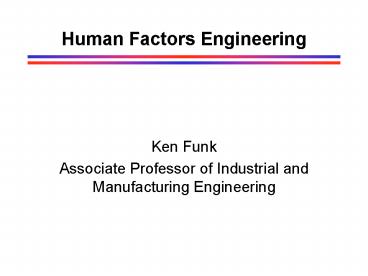Human Factors Engineering PowerPoint PPT Presentation
1 / 29
Title: Human Factors Engineering
1
Human Factors Engineering
- Ken Funk
- Associate Professor of Industrial and
Manufacturing Engineering
2
Kenneth H. Funk II, PhD
- Education
- BA, Biology, Taylor University
- MS and PhD, Industrial and Systems Engineering,
The Ohio State University - Teaching
- Computer applications
- Senior projects
- Human Factors Engineering
- Research
- Submarine Command Support System (US Navy)
- F/A-18 IAAS Task Support System (US Navy)
- Flight Deck Automation Issues (FAA)
- Cockpit Task Management (NASA)
- Operating Room Human-Machine Systems Engineering
3
What is Human Factors Engineering?
- Human Factors Engineering (HFE) is concerned with
the design of human-machine systems. - HFE seeks to achieve high levels of system
- effectiveness and
- safety.
- HFE explicitly considers human
- requirements,
- characteristics,
- capabilities,
- limitations,
- wants, and preferences.
4
(No Transcript)
5
Accidents by Primary CauseHull Loss Accidents -
Worldwide Commercial Jet Fleet 1988 Through 1997
(Source 1997 Statistical Summary of Commercial
Jet Airplane Accidents, Boeing Commercial
Airplane Group)
6
Cockpit Task Management Errors Initial
Observations
- Cockpit (flight deck) is a multitask environment
- aviate
- navigate
- communicate
- manage systems
- Results of distraction, preoccupation
- Everglades L-1011 accident
- many incidents
7
Cockpit Task Management Research
- CTM Errors in Aircraft Accidents (1991)
- 80 CTM errors in 76 (23) of 324 accidents
- CTM Errors in Critical, In-Flight Incidents
(1993) - 349 CTM errors in 231 (49) of 470 incident
reports - Part-Task Flight Simulator Study (1996)
- CTM error rate increases with workload
- ASRS Study of CTM and Automation (1998)
- Task prioritization error rate higher in advanced
technology reports - Findings
- CTM is a significant factor in flight safety
- CTM can potentially be improved
8
Statement of Need
- Computer-Based CTM aid is needed to
- maintain a current model of aircraft state and
current cockpit tasks, - monitor task state and status,
- compute task priority,
- remind the flightcrew of all tasks that should be
in progress, and - suggest that the flightcrew attend to tasks that
do not show satisfactory progress. - leave the pilot in control
- ? the AgendaManager (AMgr)
9
Simulator(with Engine Indication and Crew
Alerting System -- EICAS)
10
AMgr Architecture and Function
11
AMgr Display(replaced EICAS)
12
AMgr Operation
- simulator runs
- pilot declares goals via ATC acknowledgements
- System Actor Agents instantiate Goal Agents
- Goal Agents watch for goal conflicts
- Function Agents assess function status
- AgendaManager informs pilot via display
13
Test and Evaluation
- Objective compare AMgt performance (AMgr vs
EICAS) - Apparatus
- flight simulator
- AMgr
- Subjects 8 airline pilots
- Scenarios
- EUG to PDX
- PDX to Eugene
- Primary factor monitoring and alerting condition
- AMgr
- EICAS
14
Evaluation Results
15
Interaction Plot Pilot Performance vs. Display
Type
16
Interaction Plot Pilot Speed vs. Display Type
17
Alternative ApproachTask Management Training
- Is task prioritization trainable?
- Research suggests that voluntary control of
attention is a trainable skill - Objective
- Develop and evaluate a CTM training program to
improve task prioritization performance.
18
Methodology
- Participants
- 12 General Aviation pilots, IFR rated, with at
least 100 hrs pilot-in-command total time. - Recruited through flyers and word of mouth
- Oregon State (Corvallis, Albany, Salem, Eugene,
Portland) - Apparatus Microsoft Flight Simulator 2000
- 3 monitors, Flight Yoke, Throttles, and Rudder
Pedals - IFR conditions
- Two flight scenarios
19
Lab Setup
20
Participant Display(C-182RG)
21
Experimenters Display
22
Experimental Groups
- Control Group No Training
- Descriptive Group CTM lecture
- Multi-tasking
- Attention
- CTM
- Task Prioritization errors
- Accident/Incident examples
- What to be aware of.
- Prescriptive Group
- CTM lecture
- APE procedure
23
APEAssess Prioritize Execute
A P E
- Let the APE help you
- Assess the situation
- aircraft systems, environment, tasks, procedures
- Whats going on? What should I be doing?
- Prioritize your tasks
- Aviate Is my aircraft in control?
- Navigate Do I know where I am and where Im
going? - Communicate Have I communicated or received
important information? - Manage systems Are my systems okay?
- Execute the high priority tasks Now.
- Invoke the APE frequently.
- Think out loud.
24
Experimental Procedure
- Initial briefing, informed consent
- Initial 30-minute simulator training
- Pre-training flight
- CTM training (break for control group)
- Additional 30-minute simulator training
- Post-training flight (different scenario)
- Post-experiment questionnaire
25
Primary Dependent Measure
- Task prioritization error rate
- 19 Task prioritization challenges, e.g.
- clearance near end of climb
- bust altitude? (/- 200 ft)
26
Data Collection
- Flight Data Recorder
- Videotape
- Observation
- Data reduction to
- task prioritization error rate
- prospective memory recall rate
27
Interaction Plot(task prioritization error rate)
28
Possible Interpretations
- Results may have two interpretations
- CTM training did improve task prioritization
performance. - CTM training did not improve task prioritization.
- Floor effect
- MSFS experience
- Age
- Research favors first interpretation
- ANOVA results
- t-tests
- Potential for better control group performance
was there. - Additional tests
29
Follow-Up Experiment
- Four groups
- Control 1 (no training)
- Control 2 (no training, but knowledge of measure)
- Descriptive
- Prescriptive (slightly modified APE)
- More participants (20 5 per group)
- Pre-experiment test
- short MSFS flight, pre-experiment questionnaire
- assign so as to yield equivalent groups
- Slightly shorter scenarios

